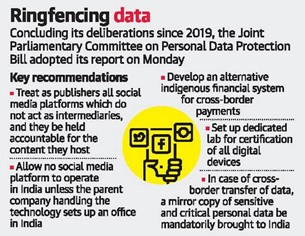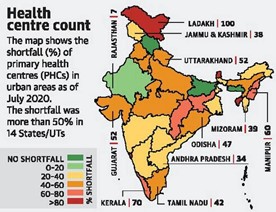Thursday, 25th November 2021
Global Nutrition Report, 2021
In News
The 2021 Global Nutrition Report (GNR, 2021) has been released on November 23, 2021.
About the Report
- The GNR is a multi-stakeholder initiative, comprising of high-level members of government, donor organisations, civil society, multilateral organisations and the business sector.
- The GNR is the world’s leading independent assessment of the state of global nutrition. GNR 2021 sets out progress towards the global nutrition targets, evaluates the impact of poor diets on our health and our planet, assesses the nutrition financing landscape, and provides a comprehensive overview of reporting on past Nutrition for Growth (N4G) commitments.
Key Findings of the Report
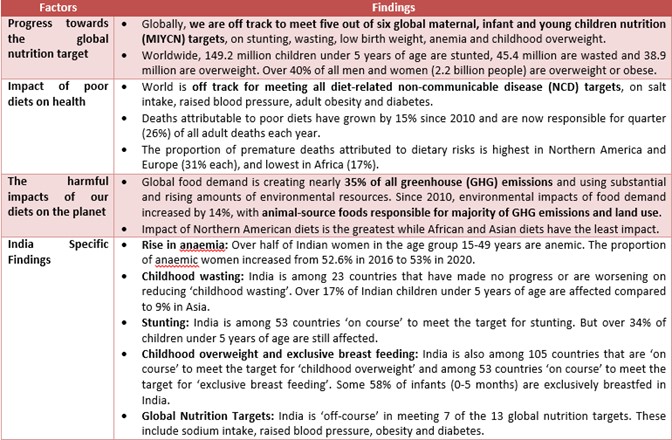
Sources:
National Family Health Survey (NFHS)-5
In News
The Total Fertility Rate (TFR), or the average number of children per woman, has declined further from 2.2 reported in 2015-16 to 2.0 at the all-India level, according to the latest National Family Health Survey (NFHS) released by the Union Health Ministry.
Findings of the NFHS-5
- Urban- Rural: The data in NFHS 2019-21, the fifth in the survey series, shows the fertility rate at 1.6 per cent in urban areas and 2.1 in rural India.
- Bank Accounts: The number of women who have a bank account they operate themselves has increased significantly from 53 per cent in 2015-16 to 79 percent, the data show.
- Nutrition: Though the gains in childhood nutrition were minimal, women and men (15-49) who had a below normal body mass index (BMI) each dropped roughly four percentage points.
- Those overweight increased by around 4 percentage points. Abnormal BMIs are linked to an increase in obesity and other non-communicable diseases (NCD).
- Increase in female sterilization: The uptake of female sterilisation has gone up to 38 per cent against 36 per cent in 2015-16. The data shows that the onus of family planning remains with women.
- Anaemia Record: India's battle with anaemia also appears to have faltered. The proportion of anaemic children (5-59 months) increased from 58% to 67%. Women aged 15-49 who were anaemic increased from 53% to 57% and men of the same age increased from 29% to 31% between both editions of the NFHS.
- Stunting: Progress is visible on stunting, which seems to be coming from change happening in big States such as Uttar Pradesh and others. These are outcomes that depend on multiple interventions and take longer to achieve.
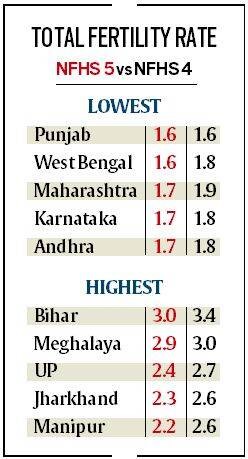
Meaning of fertility rate and Replacement rate
- Total Fertility rate: The total fertility rate in a specific year is defined as the total number of children that would be born to each woman if she were to live to the end of her child-bearing years and give birth to children in alignment with the prevailing age-specific fertility rates. This indicator is measured in children per woman.
- Replacement level fertility: It is the total fertility rate—the average number of children born per woman—at which a population exactly replaces itself from one generation to the next, without migration. This rate is roughly 2.1 children per woman for most countries, although it may modestly vary with mortality rates.
- Significance of fertility rate: High fertility rate will mean that population is growing faster and vice versa.

What is the significance of below replacement level fertility rate?
- India’s overall population size will not shrink immediately. The country is experiencing a population momentum as a result of a demographic transition.
- Even if about 31% of young people in 10 to 24 years age group will produce one or two children per couple, there will still be an absolute increase in total population.
- TFR of 2 is a “definite indicator” of stability of population in the long term in the country.
- Three key pointers from the TFR declining to 2 are:
- A diminished challenge to development,
- The importance of investing in public health and education with skills, and
- The need to focus on environmental protection.
Source:
Global State of Democracy Report, 2021
In News
The Global State of Democracy Report, 2021 released by the International Institute for Democracy and Electoral Assistance (International-IDEA) has noted increased authoritarianism in countries in 2020 than that of democracy.
Key Findings of the Report:
International IDEA bases its assessments on 50 years of democratic indicators in about 160 countries, assigning them to three categories namely
- Democracies (including those that are “backsliding”)
- Hybrid governments
- Authoritarian regimes.

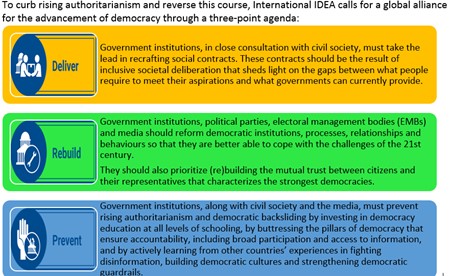

Source:
International Day for the Elimination of Violence against Women
On November 25, 1981, women's rights activists have started observing this day as a day against gender-based violence. This date was selected to honour the Mirabal sisters, three political activists from the Dominican Republic who were brutally murdered in 1960 by order of the country’s ruler. Nearly 1 in 3 women have been abused in their lifetime. In times of crises, the numbers rise, as seen during the COVID-19 pandemic and recent humanitarian crises, conflicts and climate disasters. A new report from UN Women, based on data from 13 countries since the pandemic, shows that 2 in 3 women reported that they or a woman they know experienced some form of violence and are more likely to face food insecurity. Only 1 in 10 women said that victims would go to the police for help. To raise awareness, this year's theme is "Orange the World: End Violence against Women Now!". Orange is our color to represent a brighter future free of violence against women and girls. Be part of the orange movement!

Source:
WPI-CPI Divergence
In News
The wholesale inflation across the country rose to 12.54 per cent in October, 2021, but the consumer price index (CPI) has marginally risen to 4.48 per cent in October.
What are Wholesale Price Index (WPI) and the Consumer Price Index (CPI)?
- Current Situation: An interesting observation to note during these times is the sustained levels of WPI inflation alongside low levels of CPI inflation.
- WPI and CPI are two measures of inflation in India. Base year of both the indices are 2011-12.
- Consumer Price Index or CPI as it is commonly called is an index measuring retail inflation in the economy by collecting the change in prices of most common goods and services used by consumers. It is calculated by CSO, Ministry of Statistics & Programme Implementation. In India, there are four consumer price index numbers, which are calculated, and these are as follows:
- CPI for Industrial Workers (IW)
- CPI for Agricultural Labourers (AL)
- CPI for Rural Labourers (RL) and
- CPI for Urban Non-Manual Employees (UNME).

- Wholesale Price Index, or WPI, measures the changes in the prices of goods sold and traded in bulk by wholesale businesses to other businesses. WPI is unlike the Consumer Price Index (CPI), which tracks the prices of goods and services purchased by consumers.
- The numbers are released by the Economic Advisor in the Ministry of Commerce and Industry.
- Given that the CPI measures retail prices, it is bound to be higher than the WPI, which measures wholesale prices. This has been the case for a long time now and is not a cause for concern as long as both the indices are moving in the same direction.

Reasons for Divergence

- Difference in the structure of baskets: The WPI series mainly tracks the movement of producer and bulk transaction prices and its weights are based on the value of output in different sectors of the economy. The series is akin to producer price indices compiled in other countries.
- The CPI basket is based on consumer expenditure estimates and tracks inflation at retail level or the prices consumers pay.
- Difference in weightage assigned to different goods/items that make up the two baskets. For example, in the consumers’ basket, food has a much higher weightage than in the wholesale basket. This essentially means a rise in food prices will cause a bigger spike in the CPI basket than in the WPI one.
- Inefficient inflation capturing: The divergence between the wholesale and retail prices could indicate that there is an increasing inefficiency in measurement of inflation.
- The supply chain dynamics between the farmers, producers and the end consumer is not completely captured by the current methodology leaving a significant room for improvement.
- Lag in timing: It is also important to note that WPI index is usually the lead index and CPI lags behind. It takes time for the wholesale prices to pass through to retail. WPI numbers are updated on a weekly basis whereas CPI numbers are updated on a monthly basis.
Implications of the Divergence
To some extent, the difference between CPI and WPI inflation is not only understandable but also reasonable. After all, the two indices have been made to better under how prices behave between the wholesale and retail levels. However, a growing divergence between the two creates a serious worry for all policymakers concerned.
- Impact on Monetary and Fiscal policymaking: Wedge between WPI and CPI can have cascading effect on other macro-economic variables and consequently make Monetary and Fiscal policy decision making complicated. This leads to contrasting call on monetary policy stance, with calls for monetary easing or tightening depending on which inflation one chose to follow.
- Example: It would become difficult to determine the level of liquidity for market if there is lack of clarity on inflation.
- Impact on Market Dynamics: The investment and expenditure decisions of the market highly depend on the inflation rates. Diverging inflation rates create uncertainty in demand of the market and hence influence investments. This affects the overall capital formation in the economy.
- Trust deficit among Common citizens: Diverging WPI and CPI may lead to deception to common citizens as it hurts the people as a whole. This leads to trust deficit in the policy makers and monetary authority.
- Unreliable Image of the country at the global level: Wedge between WPI-CPI indicates poor estimation of inflation. This, in turn, creates India’s image that of an unreliable economy. This image can lead to decrease in foreign investment and impact the trade relations with other countries.
Way Forward
Given that WPI-CPI Divergence is inevitable, what are the steps that can be taken by Policy makers and
- When to Use what Index: Since the control of inflation is aimed at minimising the impact of rising prices on the people, the primary focus of policy makers and particularly monetary authorities should be on CPI.
- When there is need to isolate the inflation levels of the supply-chain across the country, WPI needs to be used.
- Study of Divergence: Only a careful study of the components, its weights, the domestic & global economic contexts reveals the true drivers and enables us understand how another episode of divergence could play out. Further, there are other critical aspects too one should focus on.
- More accurate indices: There is need to shift to more accurate indices. Example, shift to PPI (Producer Price Index) from WPI. PPI measures the change in revenue received by domestic producers of goods and services in the economy. This excludes mark-ups and taxes, unlike WPI, giving a more accurate measure of underlying demand and growth.
- Extending and diversifying Statistical Resources: To better represent inflation, there is need to diversify the baskets of the indices, change the weightage as per changing economic parameters, and make the basket more indicative/ representative of the economy.
Conclusion: The dynamics of inflation capturing and targeting in a vast country like India is difficult. The policy makers and monetary authority should keep in mind the following when deciding upon its inflation measure: the target population (consumers or producers), the items that need to be included or excluded from the relevant measure, the weight attached to these items, and most importantly, the timely, reliable, accurate and frequent measurement of the prices.
Question: Discuss the reasons for divergence between the two measures of inflation in India. What are the implications of this divergence?
Sources:
- India’s WPI inflation spikes to 12.54% in October: Govt data
- Understanding the CPI-WPI divergence
- Divergence between Wholesale and Retail Inflation
- Economic Survey: 2014-15
- CPI-WPI divergence - the red sea split?
- Comparison of Consumer and Wholesale Prices Indices in India: An Analysis of Properties and Sources of Divergence
- Inflation in India: Will the switch from WPI to CPI give us a truer picture?
- What is Consumer Price Index (CPI) Inflation?
- What is Wholesale Price Index (WPI)?
- Diverging CPI, WPI: The inflation conundrum
Torrential flooding
This is image of a water fall burst forth from the Tirumala Hills onto the temple town of Tirupati recently after a torrential rain of 12-14 cm over a few hours. Low-lying areas in Tirumala as well as in Tirupati town were submerged. Huge inflows from upstream led to a sudden deluge on the national highway. The fury of floods in the temple town of Tirupati and other districts in south Andhra Pradesh took everyone by surprise, not just because torrential flooding like this has never been seen before in Tirupati but also because one of the worst drought-prone districts in the country, like Anantapur, came under water.

Source:
New mineral in a diamond
- Context: Researchers have discovered a new mineral from deep inside Earth trapped in a diamond.
- The mineral named “davemaoite” entrapped in a diamond from deep within the Earth’s lower mantle.
- The tiny crystals were form of calcium silicate that is believed to constitute 5% of the Earth’s lower mantle but had never actually been observed before.
- It is said to have radioactive elements like uranium, thorium and potassium-40.
- The molecules within it take on a particular cubic arrangement known as a perovskite structure.
- The atomic composition of this particular perovskite primarily consisting of calcium, silicon and oxygen could have formed under the extreme conditions experienced in the lower mantle, where the pressure is more than 200,000 times than that at Earth’s surface.
- Under surface conditions, calcium silicate is instead typically found as a white mineral called wollastonite that has needle-like crystals.

Source:
- New mineral 'davemaoite' made an unlikely journey from the depths of the Earth
- New mineral davemaoite discovered inside a diamond from Earth's mantle
Image Source:
Matosinhos Manifesto
- Context: The European Space Agency (ESA) council has approved a manifesto called Matosinhos Manifesto.
- The manifesto aims to accelerate the use of space in Europeto tackle the urgent and unprecedented societal, economic and security challenges faced by Europe and its citizens.
- It lays down a vision for the continent in terms of maintaining and expanding its activities in space and defines three “accelerators” to further advance Europe’s space ambitions:
- The first is for the ESA to start working towards the “Space for a Green Future”, so that people understand the current state of the planet and develop solutions for sustainable life on Earth which is in line with achieving net-zero greenhouse gas emission targets by 2050.
- The second is called “Rapid and Resilient Crisis Response”, to support governments to act decisively on crises facing Europe, from flooding and storms to wildfires.
- The third is “Protection of Space Assets”, that aims to safeguard ESA astronauts and assets from interference by space debris and space weather.
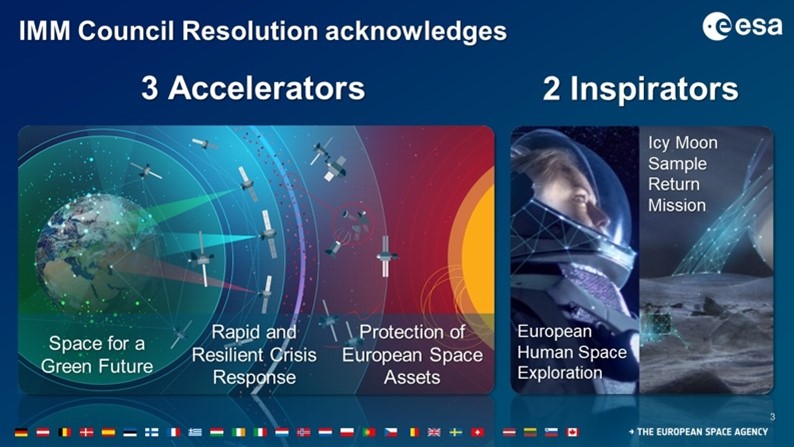
Source:
- Explained: What is the ‘Matosinhos Manifesto’, meant to accelerate the use of space in Europe?
- Matosinhos Manifesto
Image Source:
Rani Gaidinliu
- Context: Union Home Minister has recently laid the foundation for ‘Rani Gaidinliu Tribal Freedom Fighters Museum’ in Manipur.
- Rani Gaidinliu was born on January 26, 1915 at Nungkao village in Tamenglong district of Manipur.
- She was a spiritual and political leader who belonged to the Rongmei tribe of Manipur.
- At the age of 13, she joined the freedom movement and later spearheaded the socio-political movement to drive out the British.
- In 1932, she was arrested and sentenced to life imprisonment. She spent 14 years in jail and was released only after India’s Independence in 1947.
- She was awarded Tamara Patra in 1972 and Padma Bhushan in 1982 by the Government of India for her contribution to the freedom movement.
- Jawaharlal Nehru described Gaidinliu as a daughter of the hills and he gave her the title ‘Rani’ or Queen of her people
- The Union government issued a commemorative postage stamp and a Rs 100 commemorative coin in her honour.

Source:
- Manipur: Amit Shah lays foundation for ‘Rani Gaidinliu Tribal Freedom Fighters Museum’
- Rani Gaidinliu: The daughter of the Hills
Image Source:
India’s first Virtual Science Lab
- Context: Union Minister Science & Technology has recently launched India’s first Virtual Science Lab for children.
- The main aim of the Virtual Lab is to provide quality research exposure and innovative methods of teaching for school students to drive their scientific curiosity based on an online interactive medium with simulated experiments, teaching based content, videos, chat forums, animations, gaming, quiz, facility sharing, webinars etc on the subjects of Science, Mathematics, Biology and IT.
- The target audience for the VL platform is students of the standard VI to XII (11-18 years).
- It will encourage higher order thinking skills, promote entrepreneurship and develop passion about science.
- The content will initially be in English initially and later be made available in Hindi and other regional languages.
- It is launched under CSIR Jigyasa programme launched in 2017 which will also connect students with scientists across the country.

Source:
- Union Minister Dr.Jitendra Singh launches India’s first Virtual Science Lab for children under CSIR Jigyasa programme, which will also connect students with scientists across the country
- India’s first virtual science lab for children launched
Image Source:
A unified regulatory framework: TH
Essence: The article enlists the need for unified regulatory framework to measure the regulatory parity between the Telcom companies and internet companies. The fact that success of Internet firms and telcos goes hand in hand but an increasing competition could also be seen in this. There is instance where the services provided by the internet firms has led to significant reduction in revenues of telcos. One of such is Over-the-top (OTT) messaging.
Complementary value networks or “walled gardens” is also another example which is bringing new element of competition into the telcos-Internet companies’ relationship. The article also sheds light on Net Neutrality as dominant telco can hinder competition in a downstream market by a vertical merger with content and application providers. Also, as telcos and Internet firms are regulated by different entities a divergence is seen in the management. India needs a policy where convergence can be witnessed between the two.
Why you should read this article?
- To understand the integrated sphere of cooperation as well as competition between telcos and Internet companies.
- To understand what steps should be taken to reduce the competition between the two spheres.
Source:
The future of India’s coal ecosystem: HT
Essence: The article talks about the multifaceted role of the coal in everyday life and economies across India. From providing employment for nearly four million people to generating CSR spending, role of coal is being under appreciated by environmentalists and western commentators. As India has pledged to “phase down” coal for being the dirtiest of fossil fuel, India should plan its transition carefully owing to the positives it has for Indian economy.
The transition should involve creating a multi stake holder body who could guide the process along with Centre taking lead in coordinating transition policies for coal-dependent states and providing finance for policy implementation. Along with sensitizing the stakeholders’ huge finances would be required to implement the transition measures.
Why you should read this article?
- To understand the positives that the coal serves in context of Indian economy.
- To understand how India should plan its transition to phase down coal.
- The article provides crucial points to support India’s stance on being coal dependent economy. (GS-3 , Infrastructure)
Source:
The decentralisation charade of urban local bodies: ORF
Essence: Decentralization is one of the most important tools for good governance in a federal polity. Problem arises when none of the government levels wants to part with the power it has on institutions. In this light, discussion on Urban Local Bodies (ULBs) becomes important. Since cities are the first recipients of changes in technology and management, their good governance is crucial and thus ULBs have prominent role. The matter of empowering and decentralizing ULB started by the passing of 74th Amendment Act. Urban Development is a state subject. But the centre works to retain all of its power base and keeps looking for areas of expansion of its authority.
States have been complaining of centre not respecting the principles of federalism. However, the states themselves have not been taking any initiative to alter the statutory framework of ULBs. Moreover, ULBs have been blaming on the interference of states in their local functioning. ULBs themselves have been hesitant in constituting ward committees. Apart from these issues, direct citizen participation provided in the 74th Amendment Act, has been overlooked by many states. Though GOI’s Model Nagar Raj Bill was an attempt in that direction but the states did not respond positively. Due to all these issues, in case of ULBs, decentralization becomes just a deceptive outward appearance or a facade.
Why should you read this article?
- To understand the role of ULBs and how decentralization of ULBs is not a successful story
- To know that struggle in India for institutionalising citizen’s participation in ULBs has been an unsuccessful struggle.
- It is an important article which talks about the problems in the federal structure and Urban Local Governance (GS II).
Source:
Lilabati as a water champion of Jhargram
Background
- Monsoon plays a vital role in the agriculture of India, especially for the economically weaker section of the society.
- Jhargram in West Bengal inhabited by Advasi community faces the brunt of thinning of monsoon rains.

How Water conservation became a lifestyle in Jhargram?
- An agricultural labourer Lilabati from a village in Binpur, has been mobilizing hundreds of village women to erect and lay water conservation structures in the water-scarce region.
- Her early life had various struggles, from her in-laws to financial stress, but she found her way out through ideas like self-help groups and vegetable farming as livelihood.
- As her village in a drought-prone area, she soon understood the need for water conservation, and womenfolk of the village starting seeking her advice for the same.
- A major turn was that even the men of the village were interested in the techniques she used.
- She mobilized the villagers to dig a pond in the village and also registered the work under
- She has been successful in imbibing the knowledge of resource management and water conservation in the region.
- She has identified as a ‘water champion’ by the United Nations Development Programmes.
Quote:
“You don’t have to play masculine to be a strong woman.” —Mary Elizabeth Winstead,
Source:
Share the article
Get Latest Updates on Offers, Event dates, and free Mentorship sessions.

Get in touch with our Expert Academic Counsellors 👋
Frequently Asked Questions
UPSC Daily Current Affairs focuses on learning current events on a daily basis. An aspirant needs to study regular and updated information about current events, news, and relevant topics that are important for UPSC aspirants. It covers national and international affairs, government policies, socio-economic issues, science and technology advancements, and more.
UPSC Daily Current Affairs provides aspirants with a concise and comprehensive overview of the latest happenings and developments across various fields. It helps aspirants stay updated with current affairs and provides them with valuable insights and analysis, which are essential for answering questions in the UPSC examinations. It enhances their knowledge, analytical skills, and ability to connect current affairs with the UPSC syllabus.
UPSC Daily Current Affairs covers a wide range of topics, including politics, economics, science and technology, environment, social issues, governance, international relations, and more. It offers news summaries, in-depth analyses, editorials, opinion pieces, and relevant study materials. It also provides practice questions and quizzes to help aspirants test their understanding of current affairs.
Edukemy's UPSC Daily Current Affairs can be accessed through:
- UPSC Daily Current Affairs can be accessed through Current Affairs tab at the top of the Main Page of Edukemy.
- Edukemy Mobile app: The Daily Current Affairs can also be access through Edukemy Mobile App.
- Social media: Follow Edukemy’s official social media accounts or pages that provide UPSC Daily Current Affairs updates, including Facebook, Twitter, or Telegram channels.


